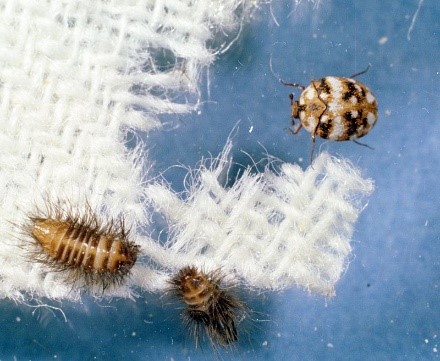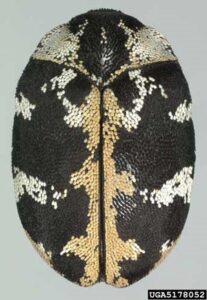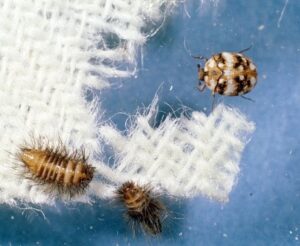Fabric-destroying insects cause losses in commercial fabric and garment manufacturing or storage operations. Materials that are readily infested are wool carpet, sweaters, coats, upholstery, rugs, blankets, furs, hair, leather, feathers, horns, insect and animal collections, dead rodent carcasses (hair, nails), and stored foods (meat, fish, meal, and dried milk products). dead rodent carcass (hair, nails)

Insect pests of fabrics are troublesome because of their ability to digest and use a natural protein called “keratin” as an energy source. Keratin is the main component of human tissues (hair, fingernails, and skin) and mammals (horns, hooves, and feathers). The ability to digest keratin, combined with the widespread use of wool and other vertebrate animal hair, is the basis of fabric pest problems.
Fabric pests are naturally occurring outdoors and enter houses and facilities through doors and windows, or can be accidentally brought indoors on improperly stored, infested items.
The most common fabric insects are:
I – Clothes Moths or Tapestry Moths (Family Tineidae and Order Lepidoptera)
- Webbing Clothes Moth – Tineola bisselliella (Hummel)
- Casemaking Clothes Moth – Tinea pellionella Linneuas
- Carpet Moth – Trichophaga tapetzella (Linneuas)
II – Carpet Beetles (Family Dermestidae and Order Coleoptera)
- Common Carpet Beetle – Anthrenus scrophulariae(Linnaeus)
- Black Carpet Beetle – Attagenus unicolor (Brahm)
- Furniture Carpet Beetle – Anthrenus flavipes LeConte
Other insects (silverfish, cockroaches, crickets, and earwigs) are capable of damaging fabrics by chewing or shredding, but they do not have the ability to digest keratin. Therefore, they are not considered true fabric pests.
Click on each species to learn about its identification/description, life cycle, common characteristics, damage, and economic implications.
I – Clothes Moths
Common characteristics of clothes moths:
- These are all small moths, with wingspans of less than 1.25 cm.
- Rarely seen flying around lights at night, as carpet beetles will.
- Prefer dark closets.
- Tend to live in dark corners or in folds of fabric.
- Newly emerged adults of both sexes fly readily, usually at dusk.
- Females seek out suitable areas for egg-laying, where suitable food materials for development of the larvae are present.
- Clothes moths have a complete metamorphosis.
- Adults are unable to feed.
- Only larvae damage fabrics and other keratin-containing items, as they feed.
- Webbing Clothes Moth
General Description
- The body and wings of the adult are uniformly buff in color,
and its head has lightly reddish hairs on top. - The wings are silvery brown to golden tan in color,
without spots, and measure less than 0.7 cm across when extended.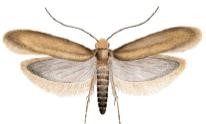
- Adult males are capable of flying, but seldom do so.
- Females are not good fliers, although they can fly for
short distances within homes and elsewhere. - Adults normally live about 15 to 30 days,
and longer in colder weather this time - Larvae are shiny, creamy white in color,
and not more than 1.25 cm long. - Eggs are oval, ivory-colored, and 1 mm long.
Life Cycle and Common Characteristics
- Eggs are laid singly or in small groups among the threads or in the cracks of a suitable food material.
- Eggs are attached to this food material with a gelatinous secretion.
- The female lays 40 to 50 eggs (up to 200), but in the summer, eggs hatch in 4 to 10 days (1 month in the winter).
- Each larva molts up to 10 times during its development.
- The larva then spins a silken pupal case and attaches bits of fiber to the outside of it.
- Length of the pupal stage varies from about 8 to 40 days.
- The entire life cycle may vary from 55 days to four years, but normally between 65 and 90 days.
Damage and Economic & Health Implications
- Adult webbing clothes moths may be found at any time of the year, but are more abundant during the warm summer months. They also develop in heated buildings in the winter.
- Larvae produce randomly placed patches of silken webbing as they move about on the surface of a cloth article they are attacking.
- Webbing is generally sparse in fur, but it may be present at the base of the hairs.
- Casemaking Clothes Moth
General Description
- This moth is browner in color than the webbing clothes moth
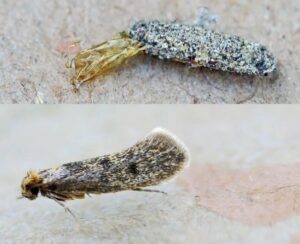
and has three dark spots on the wings, which help to identify it. - Adults vary in size as compared to the webbing clothes moth,
depending on the larval diet. - No tuft of reddish hairs arising from the top of the head of adult of
this moth are apparent, compared to the hairs of the webbing clothes moth.
Life Cycle and Common Characteristics
- The larva spins a small silken cell, bag or case around itself and carries it about while it feeds. It moves about by extending its head and legs from the front end of the case.
- Larvae wander about on food material and slightly feeding on these materials. It is rarely do extensive damage at any one spot or in a small area.
- When ready to pupate, the larva draws itself completely within its case, seals both ends of the case with silk, and pupates in its cocoon.
Damage and Economic & Health Implications
- This moth is a pest of feathers, but it can feed on almost any material listed as food for webbing clothes moths.
- Carpet Moth
General Description
- The adult wingspread is greater than that of either the
webbing or casemaking clothes moths. - Carpet moths can be distinguished from these other species
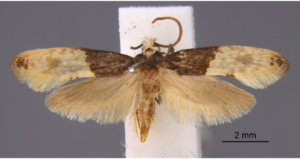
by the fact that the front third of the forewing is black and the
rest of the wing is white, with a few black or gray spots. - The adult moth’s head is white.
- The larva makes a silk tube as it burrows through the
material on which it feeds, and it feeds inside this tube.
Life Cycle and Common Characteristics
- The life cycle of this species is similar to that of the preceding species.
Damage and Economic & Health Implications
- Carpet moth causes considerable damage when a severe infestation occurs. It is most common in old woolens, horse hair, furs, and feathers.
II – Carpet Beetles
Common characteristics of clothes beetles:
- Larvae of these beetles are the only stage that causes damage to fabrics.
- Adults are small and inconspicuous beetles rarely seen by homeowners.
- Adults may be found indoors or outdoors on flowers surrounding the house, where they feed on nectar and pollen.
- Several flowering shrubs are attractive to some carpet beetles.
- Adult carpet beetles fly readily and actively when indoors, and are attracted to windows and lamps or light fixtures.
- Common Carpet Beetle
General Description
| · Adults of this carpet beetle are small, rounded, and gray to blackish in color with white and orange scales on the back.
· Orange-red band of scales are found on the middle of the back surface.
|
Credit: Natasha Wright,bugwood.org.
|
| · The larva is an elongated, oval shape and is rarely more than 0.6 cm long.
· Larvae are reddish brown and covered with numerous black or brown hairs. · Eggs are white.
|
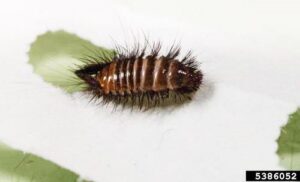 Credit: Joseph Berger, bugwood.org. Credit: Joseph Berger, bugwood.org. |
Life Cycle and Common Characteristics
- Adult beetles feed on nectar and pollen in flowers.
- Each female deposit 30 to 40 small.
- Eggs hatch in 10 to 20 days.
The larva molts 6 times over a period of 60 to 70 days. - Pupation occurs in the last larval skin.
The pupal stage lasts for 12 to 15 days. - The adult remains in the old larval skin for about 18 days before becoming active.
Damage and Economic & Health Implications
- Larvae of this beetle often cause damage to carpets, textiles, fabrics, furs, feathers, museum specimens and similar materials.
- This beetle may cause dermatitis (skin irritation) when human skin comes in contact with shed larval skins.
- Damages on infested items as irregular holes. In museum damaged specimens are eaten by the larvae which they leave a fine dust around or beneath the specimen.
- Black Carpet Beetle
General Description
| · Adults are shiny black with brownish legs and 0.3 to 0.5 cm in length.
|
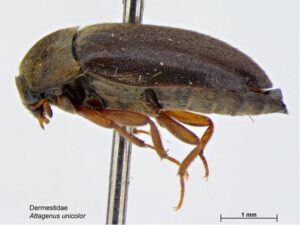 Credit: Caroline Harding, PaDIL Credit: Caroline Harding, PaDIL |
| · Larvae are tiny when they hatch.
· Larvae have distinctive elongated carrot- or cigar-shaped bodies and long, brushy tail bristles. · Larvae body color varies from a light brown to almost black.
|
 Credit: CSIRO Credit: CSIRO |
Life Cycle and Common Characteristics
- Females lay eggs either indoors or outdoors, beginning 4 to 8 days after the adult emerges.
- Each female lays about 50 eggs over a period of about three weeks, after which she dies.
- Eggs hatch in six to 11 days in warm weather.
- Larvae may grow to 1.25 cm long over a series of five to 11 molts.
- Larvae may live from 9 months to 3 years, depending on their diet and environmental conditions.
- Larvae pupate in the last larval skin, with the pupal state lasting from 6 to 24 days.
Damage and Economic & Health Implications
- Black carpet beetles are found outdoors in flowers and are most numerous in the spring and early summer.
- Mature larvae can wander rather widely, so they may be found anywhere in a building.
- Larvae are found in a bathtub, kitchen sink or even crawling on walls and ceilings.
Larvae are general feeders, feeding on dead animal materials, hair, fur, hides, and horns, and occasionally on woolen products. - Larvae frequently burrow through containers to obtain food, leaving small openings through which other insects may enter to cause additional damage.
- Cast skins and frass are found on infested items and fabrics.
- Furniture Carpet Beetle
General Description
- Adults are small, rounded, and blackish, with a mottling of yellow

and white scales on the back and a heavy coating of yellow scales
on the femur of the legs. The color pattern varies from yellow to white scales.
Life Cycle and Common Characteristics
- Females lay a total of 35 to 100 eggs in one to three batches.
- Eggs hatch in three weeks.
- Larvae then develop through 6-12 molts over a period of 3-6 months.
- Larvae are oval-shaped, somewhat elongated, and thickly covered with brownish hairs.
- The pupa is white and develops in the last larval skin.
- The pupal stage lasts from 14 to 19 days.
- The adult remains in the pupal skin for one to 10 weeks before becoming
Damage and Economic and Health Implications
- Furniture carpet beetles attack upholstered furniture, where they feed any suitable food source (hair, padding, feathers and woollen items).
- They also feed on other woollens, carpets, fur, bristles, horns, silk, and also feed.
- Individuals in close association with infested items may suffer allergic reactions as a result of exposure to beetle fragments, cast skins, or dusts.

